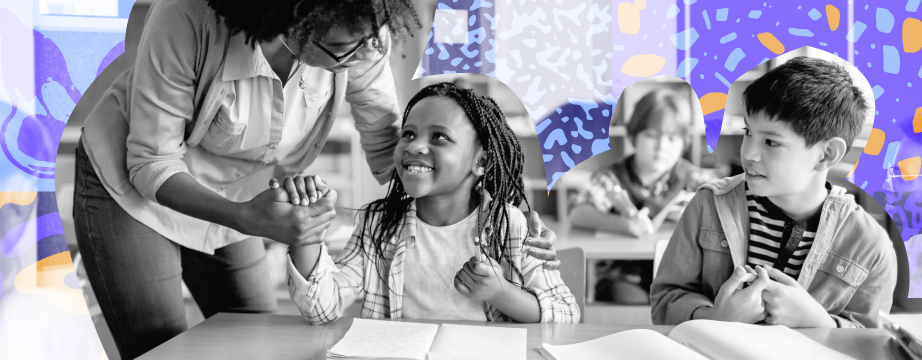How to Address Trauma Related to Curriculum Violence

Growing up in the South Side of Chicago, Keisha Rembert recalls what it was like attending a Catholic school, where students of her background were not well-represented. Her parents are migrants from the Jim Crow South, and people who looked like her were never talked about in positive ways at school.
“I shut down and I didn’t engage because I wasn’t equipped to challenge the power dynamic in that classroom with the truth,” said Rembert, who grew up to become a U.S. history and English teacher in middle school for 17 years. Still based in Chicago, she now “teaches teachers” as an assistant professor.

Rembert’s experience is one that many students still encounter. Sometimes referred to as curriculum violence, trauma endured in the classroom can affect students at all levels, underscoring the importance for teachers and stakeholders to understand and prevent it.
What Is Curriculum Violence?
Curriculum violence refers to the subjective curricular choices around lesson planning or learning experiences that cause a student psychological harm, intellectually and/or emotionally. These educational interactions can exacerbate historical or institutional trauma, particularly for historically oppressed and marginalized groups such as people of color, women, people of varying faith, members of the LGBTQ community, people with disabilities, dual-language learners and people from immigrant populations.
“Violence can apply to anything that makes somebody feel unworthy, less than or not valued,” said Elana Goldbaum, a history educator at an all-girl independent school in Los Angeles.
Contributing Factors to Curriculum Violence
Delivery Format of Activities
Example: Numerous educators have been criticized for their lessons around slavery that have ranged from forcing students to argue in defense of the practice to picking cotton in fields.
Content Choices
Example: Teaching the truth is paramount. But many students’ only experiences learning about Jewish history are lessons related to the Holocaust, which can also elicit strong emotions.
Unbalanced Perspectives
Example: The “Age of Exploration” is often taught from a European-perspective, which can downplay the genocide many people indigenous to the Americas endured.
Inadequate Time on Topics
Example: Teachers may dedicate specific months to focus on the historic contributions of Black Americans or women rather than infusing their perspectives into the entire curriculum.
Erasure of Groups
Example: Refusing to acknowledge the queer identity of historic scholars, artists, scientists and politicians erases the queer community’s contributions to history.
In-Classroom Behavior
Example: Assigning gendered roles for specific tasks like note taking to girls can inadvertently reinforce stereotypes.
“It’s not only what is done, but what is not done that can make a young person, who is deep in their developmental stages, feel like they’re not important or that they are only seen as a victim or not as good as other people profiled in history,” Goldbaum said.
While curriculum violence may include acts that are explicitly racist, xenophobic, misogynistic, or homophobic, the concept is more nuanced and many teachers are often unaware that they may be inflicting trauma by the curricular choices they make.
To provide the best educational experience for students, teachers can reflect on their own unconscious biases as well as larger biases that have influenced education. But they aren’t perfect and acknowledging that they, too, are developing and learning can go a long way in helping students avoid trauma, Goldbaum said.
What Are Signs That Students Are Experiencing Trauma From Curriculum Violence?
The effects of curriculum violence can be lasting.
“Curriculum violence creates a social, emotional and mental disconnect that is absolutely visible for oppressed or marginalized students in a classroom,” Rembert said.
The National Child Traumatic Stress Network’s guide, “Addressing Race and Trauma in the Classroom: A Resource for Educators (PDF, 1.3 MB), ” summarized some of the effects of trauma that teachers may see among students:

AGES 3-5:
Recreating the event, loss of sleep, trouble eating and startled reaction to loud sounds or sudden movements.

AGES 6-11:
Distractibility, worry or preoccupation with safety and changes in classroom performance (withdrawal, for example).

AGES 12-17:
Fixation on the subject that is causing anxiety.
When students struggle to reconcile their identities and the lessons, they may be experiencing trauma from curriculum violence.
“Whether it’s the fact that I might feel worthless because I don’t see myself represented or I don’t see myself affirmed, or that the curriculum is worthless, both affect me in the long run and have the potential to lead to visible trauma,” Rembert explained.
What Can Teachers Do to Avoid Causing Trauma Related to Curriculum Violence?
To help avoid curriculum violence, some teachers are adopting a social justice curriculum, which refers to lessons designed to broaden student’s views so they learn to challenge, change and improve conditions.
For example, when California passed a mandate requiring that teachers include queer history in classes, it prompted more careful lesson-planning and discussion about how to tell these stories.
As Goldbaum worked on developing LGBTQ history lessons, she began thinking through her own set of questions.
“My journey started with asking, OK, how can I work this into what the curriculum already has?” she said. “Now, I’m asking, How can I teach these stories without starting with oppression? That applies to every single group.”
Self-Reflection Questions for Teachers
“Because we all have intersections of our identities and some of our identities are not visible [i.e., economic status], all educators must engage and review their curricula and curricular policies from multiple perspectives to ensure violence and trauma are not an educational byproduct in classrooms,” Rembert said.
Rembert and Goldbaum provided eight questions for educators to use for self-reflection as they design lessons:
- Who am I designing the lesson for–the students or me?
- What is my knowledge about the subject that I am teaching?
- What are my implicit biases?
- Have I considered what knowledge my students bring to the classroom based on their own cultures and identities and how do I allow them to benefit from that?
- Does my lesson center the humanity of all my students?
- Have I included specific, inclusive examples?
- What are the liberatory qualities of my lesson: Does it encourage students to engage in inquiry? Does it promote creativity, experimentation and dreams? Does it encourage them to fail without harm?
- How do systems of oppression show up in the classroom and my school community and how do I work to dismantle that on a daily basis?
Strategies for Curriculum Violence Trauma Prevention
In addition to being intentional about lesson plans, teachers can reduce chances of causing trauma related to curriculum violence by ensuring their actions support the lessons. Rembert and Goldbaum shared these tips for educators:
- Ask your students how they want to be identified. Consider that they might be more comfortable answering a questionnaire they can submit the next day.
- Treat students equitably. Don’t segregate them by gender or other characteristics.
- Share with students when your own knowledge about a subject is still developing.
- Encourage questions, even difficult ones, and be honest when it is complicated.
- Teach students to share when they feel harmed. Recognize their discomfort.
- Create time and space for peace in the classroom. Students may need time to decompress.
Rembert acknowledged there are challenges getting more educators and administrators to accept that curriculum violence exists.
She encourages educators who understand to remain undeterred and make the following commitment as they enter the classroom everyday: “[I will continue] the daily work of building brave spaces in my classroom, safe spaces, having conversations, allowing students to exist and allowing them to lead conversations at whatever age.I have to be sure that I’m always including them, and I have to be sure that I’m modeling how to ask and how to answer those questions [that they need to ask] in ways that don’t create that harm, but that push us to have the difficult conversations that we need to have.”
Educational Resources
Black Lives Matter at School: National coalition advocating for racial justice in education and providing classroom kits, guides and visuals for all ages.
Building Anti-Racist White Educators (BARWE): Group provides tools for learning, introspection and having conversations about issues of racism in schools, classrooms and communities.
Learning for Justice: Organization provides articles and tools to educators who work with children from kindergarten through high school covering topics such as affirming black lives without inducing trauma and a culturally responsive curriculum.
National Association of School Psychologists, Social Justice: Central page directs visitors to tips for educators on understanding implicit bias, supporting refugee youth and more.
National Council of Teachers of English Committee Against Racism and Bias in the Teaching of English: Helpful tips on anti-racist language teachers can use and qualities of anti-racist curricula.
Organization of American Historians (OAH), Trauma and Trigger Warnings in the History Classroom: A Roundtable Discussion: Transcript from panel on teaching violent and traumatic subjects.
Rethinking Schools: Nonprofit publisher and advocacy organization is dedicated to sustaining and strengthening public education through social justice teaching and education activism.
Teaching for Change: Organization provides teachers and parents with tools to create schools where students learn to question and rethink the world, build a more equitable, multicultural society and become active global citizens.
Understood.org, What Is Culturally Responsive Teaching?: Hub of information on how educators can implement culturally responsive teaching practices and why it’s important.
Zinn Education Project: Organization encourages history education, emphasizing those who often receive only token attention (workers, women, people of color), and also on how people’s actions shaped our society.
